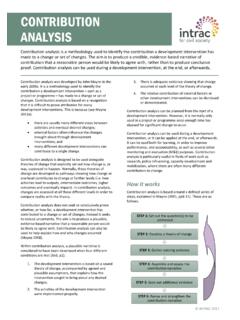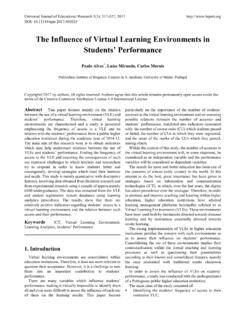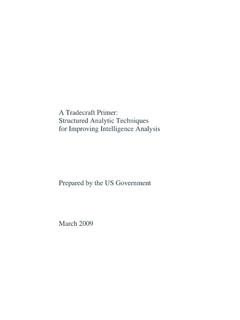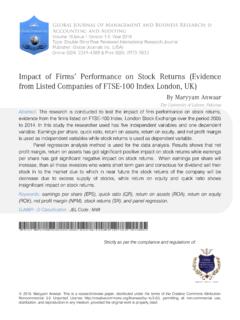Transcription of Performance Attribution Analysis - Riordan Consulting
1 Performance Attribution Analysis Preface Performance Attribution interprets how investors achieve their Performance and measures the sources of value added to a portfolio. This guide describes how returns, relative to a benchmark, are broken down into Attribution effects to determine how investors achieve Performance and measure the sources of value added to a portfolio. About Performance Attribution For investment managers to evaluate their job Performance , they need to know how they achieved their Performance results. In particular, they need to know whether their success is the result of their ability to effectively allocate their portfolio s assets to various segments, their ability to effectively select securities within a given segment or the combined effect of their selection and allocation within a segment.
2 Performance Attribution interprets how investors achieve their Performance and measures the sources of value added to a portfolio. To determine success, investors establish a benchmark, which they seek to outperform. Value added is the amount the return achieves in excess of the benchmark. Different Attribution Methods There are generally considered to be three basic forms of Attribution . These include multi-factor Analysis , style Analysis and return decomposition Analysis . The highlights of each are as follows: Multi-Factor Analysis Attributes Performance to factors such as P/E ratio, economy, bond durations, etc Used by academics and sophisticated firms More difficult to calculate Requires a great deal of data (economic/fundamental) Difficult to explain Not widely accepted in industry Style Analysis Developed by noble laureate William Sharpe (Sharpe ratio) Uses portfolio rates of return to determine investment style Easy to calculate (requires benchmark and portfolio returns) Easy to explain (uses regression Analysis ) Not widely accepted in industry Return Decomposition Analysis Attributes Performance vs.
3 Benchmarks Can focus on allocation (top/down approach) or selection (bottom up approach) Easy to calculate ( requires benchmark and portfolio returns and weights) Easy to understand and explain Used by large portion of investment community Widely accepted in industry As the return decomposition Analysis is most widely used and accepted, this is the model we will examine. About Attribution Effects In a return decomposition Analysis model, value added to a portfolio s return is commonly referred to as the active management effect. The active management effect is the difference between the total portfolio return and total benchmark return. It is also the sum of the following investment decisions or effects: Allocation Selection Interaction Defining the Allocation Effect The allocation effect measures an investment manager s ability to effectively allocate their portfolio s assets to various segments.
4 A segment refers to assets or securities that are grouped within a certain classification such as Equity, Fixed, or Technology. The allocation effect determines whether the overweighting or underweighting of segments relative to a benchmark contributes positively or negatively to the overall portfolio return. Positive allocation occurs when the portfolio is overweighted in a segment that outperforms the benchmark and underweighted in a segment that underperforms the benchmark. Negative allocation occurs when the portfolio is overweighted in a segment that underperforms the benchmark and underweighted in a segment that outperforms the benchmark. Scenario 1 A positive allocation effect occurred because the portfolio weight was greater than the benchmark weight and the benchmark return was greater than the total benchmark return.
5 The investment manager overallocated assets to a segment that outperformed the total benchmark. Scenario 2 A negative allocation effect occurred because the portfolio weight was greater than the benchmark weight and the benchmark return was less than the total benchmark return. The investment manager overallocated assets to a segment that underperformed the total benchmark. Scenario 3 A negative allocation effect occurred because the portfolio weight was less than the benchmark weight and the benchmark return was greater than the total benchmark return. The investment manager underallocated assets to a segment that outperformed the total benchmark.
6 Scenario 4 A positive allocation effect occurred because the portfolio weight was less than the benchmark weight and the benchmark return was less than the total benchmark return. The investment manager underallocated assets to a segment that underperformed the benchmark. Calculating the Allocation Effect The following calculation is used to calculate a portfolio s allocation effect. The following example shows how return decomposition Analysis calculates the portfolio s allocation effect. Example: Benchmark = S&P 500 Benchmark segment = S&P 500 Technology Benchmark return = 9% Benchmark weight = 7% Portfolio technology return = 8% Portfolio technology weight = 15% Total benchmark return = 7% The allocation effect can be expressed in percentages or basis points (bps) as follows: The allocation effect in this example is positive because the manager overweighted the Portfolio Technology segment, which performed better than the total benchmark for the portfolio.
7 Defining the Selection Effect The selection effect measures the investment manager s ability to select securities within a given segment relative to a benchmark. The over or underperformance of the portfolio is weighted by the benchmark weight, therefore, selection is not affected by the manager s allocation to the segment. The weight of the segment in the portfolio determines the size of the effect the larger the segment, the larger the effect is, positive or negative. The table that follows displays two possible scenarios for the selection effect: Selection Effects Table Scenario 1 A positive selection effect occurred because the portfolio return was greater than the benchmark return.
8 The investment manager made good decisions in selecting securities that, as a whole, outperformed similar securities in the benchmark. Scenario 2 A negative selection effect occurred because the portfolio return was less than the benchmark return. The investment manager made poor decisions in selecting securities that, as a whole, underperformed similar securities in the benchmark. Calculating the Selection Effect The return decomposition model uses the following calculation to calculate a portfolio s selection effect: The following example shows how a portfolio s selection effect is calculated. Example: Benchmark = S&P 500 Benchmark segment = S&P 500 Technology Benchmark return = 9% Benchmark weight = 7% Portfolio technology return = 8% Portfolio technology weight = 15% Total benchmark return = 7% The selection effect can be expressed in percentages or basis points (bps) as follows: There is a negative selection effect in this example because the manager selected securities that did not perform as well as the securities in the benchmark for the same segment.
9 Defining the Interaction Effect The interaction effect measures the combined impact of an investment manager s selection and allocation decisions within a segment. For example, if an investment manager had superior selection and overweighted that particular segment, the interaction effect is positive. If an investment manager had superior selection, but underweighted that segment, the interaction effect is negative. In this case, the investment manager did not take advantage of the superior selection by allocating more assets to that segment. Since many investment managers consider the interaction effect to be part of the selection or the allocation, it is often combined with the either effect.
10 The table that follows displays four possible scenarios for the interaction effect: Interaction Effects Table Scenario 1 A positive interaction effect occurred because the portfolio weight was greater than the benchmark weight and the portfolio return was greater than the benchmark return. The investment manager exercised good selection and overallocated assets to that segment. Scenario 2 A negative interaction effect occurred because the portfolio weight was greater than the benchmark weight and the portfolio return was less than the benchmark return. While the investment manager overweighted the portfolio securities for a given segment, that segment underperformed against the benchmark return for the same segment.







